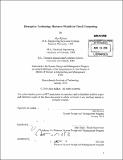| dc.contributor.advisor | John Grace. | en_US |
| dc.contributor.author | Krikos, Alexis Christopher | en_US |
| dc.contributor.other | System Design and Management Program. | en_US |
| dc.date.accessioned | 2010-10-12T18:58:17Z | |
| dc.date.available | 2010-10-12T18:58:17Z | |
| dc.date.copyright | 2010 | en_US |
| dc.date.issued | 2010 | en_US |
| dc.identifier.uri | http://hdl.handle.net/1721.1/59255 | |
| dc.description | Thesis (S.M. in System Design and Management)--Massachusetts Institute of Technology, Engineering Systems Division, System Design and Management Program, 2010. | en_US |
| dc.description | Cataloged from PDF version of thesis. | en_US |
| dc.description | Includes bibliographical references. | en_US |
| dc.description.abstract | Cloud computing, a term whose origins have been in existence for more than a decade, has come into fruition due to technological capabilities and marketplace demands. Cloud computing can be defined as a scalable and flexible shared computing solution in which third-party suppliers use virtualization technologies to create and distribute computing resources to customers on-demand, via the Internet browser. Cloud computing is steadily replacing more rigid software and services licensing models in both small/medium business (SMB) and in the enterprise. This analysis poses a twofold examination of cloud computing as a disruptive technology. First, cloud computing has replaced existing software and services licensing business models, owing to its scalability, flexibility, and utility-based pricing. Second, as cloud computing takes hold as the prominent computing services business paradigm, other disruptive forces will surface to further integrate and differentiate the cloud computing landscape. These forces include the customer-driven need to create hybrid clouds between private and public cloud domains, vendor-agnostic solutions in the cloud, along with open standards to make cloud computing ubiquitous. Three criteria are assessed in characterizing cloud computing as a disruptive technology (Christensen, 2002).1 First, cloud computing as an innovation, must enable less-skilled and/or less-wealthy individuals to receive the same utility as only the more-skilled and/or more-wealthy intermediaries could formerly attain. Second, cloud computing must target customers at the low end of a market with modest demands on performance, but with a performance trajectory capable of exceeding those demands and thus taking over markets, tier by tier. As a corollary to this second criterion, the cloud computing business model allows the disruptive innovator to achieve attractive returns at prices that are unattractive to the incumbents. Third, an ecosystem in the form of a fully integrated single entity or a set of modular entities is required to successfully support the disruptive innovation. The analysis has shown that cloud computing is replacing traditional outsourcing and premise-based data centers for software applications and services delivery. Scalability, flexibility, virtualization, and cost are essential business drivers. However, current cloud computing solutions, especially in the enterprise, lack sufficient security and customer control. This gives rise to numerous subordinate disruptive business solutions which enable the enterprise and emerging demographics to develop and deploy their applications and services in a secure, controlled, profitable, and ubiquitous environment. | en_US |
| dc.description.statementofresponsibility | by Alexis Krikos. | en_US |
| dc.format.extent | 80 p. | en_US |
| dc.language.iso | eng | en_US |
| dc.publisher | Massachusetts Institute of Technology | en_US |
| dc.rights | M.I.T. theses are protected by
copyright. They may be viewed from this source for any purpose, but
reproduction or distribution in any format is prohibited without written
permission. See provided URL for inquiries about permission. | en_US |
| dc.rights.uri | http://dspace.mit.edu/handle/1721.1/7582 | en_US |
| dc.subject | Engineering Systems Division. | en_US |
| dc.subject | System Design and Management Program. | en_US |
| dc.title | Disruptive technology business models in cloud computing | en_US |
| dc.type | Thesis | en_US |
| dc.description.degree | S.M.in System Design and Management | en_US |
| dc.contributor.department | System Design and Management Program. | en_US |
| dc.contributor.department | Massachusetts Institute of Technology. Engineering Systems Division | |
| dc.identifier.oclc | 667662907 | en_US |

